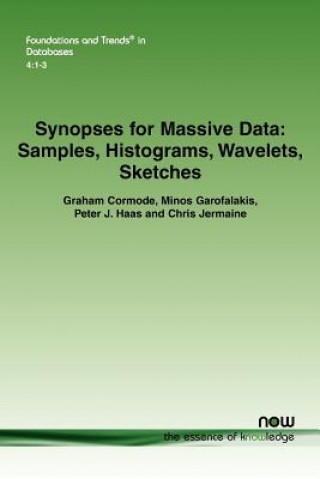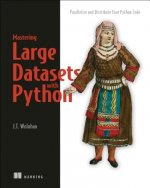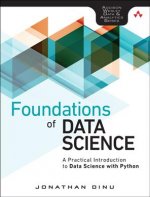
Kód: 04834883
Synopses for Massive Data
Autor Graham Cormode, Minos Garofalakis, Peter J. Haas
Synopses for Massive Data: Samples, Histograms, Wavelets, Sketches describes basic principles and recent developments in building approximate synopses (i.e., lossy, compressed representations) of massive data. Such synopses enable ... celý popis
- Jazyk:
 Angličtina
Angličtina - Vazba: Brožovaná
- Počet stran: 308
Nakladatelství: Now Publishers Inc, 2011
- Více informací o knize

Mohlo by se vám také líbit
-

Using Informational Text to Teach To Kill A Mockingbird
1645 Kč -

Role of Regions and Sub-National Actors in Europe
4288 Kč -

Women's Entrepreneurship in the 21st Century - An International Multi-Level Research Analysis
3634 Kč -

Nutrition and Health
701 Kč -

Bass Player's Guide To Jamming
758 Kč -

Long Day's Journey into Night
171 Kč -

Weihnachten in Wichtelhausen, 1 Audio-CD
352 Kč
Dárkový poukaz: Radost zaručena
- Darujte poukaz v libovolné hodnotě a my se postaráme o zbytek.
- Poukaz se vztahuje na celou naši nabídku.
- Elektronický poukaz vytisknete z e-mailu a můžete ihned darovat.
- Platnost poukazu je 12 měsíců od data vystavení.
Více informací o knize Synopses for Massive Data
Nákupem získáte 278 bodů
 Anotace knihy
Anotace knihy
Synopses for Massive Data: Samples, Histograms, Wavelets, Sketches describes basic principles and recent developments in building approximate synopses (i.e., lossy, compressed representations) of massive data. Such synopses enable approximate query processing, in which the user's query is executed against the synopsis instead of the original data. The monograph focuses on the four main families of synopses: random samples, histograms, wavelets, and sketches. A random sample comprises a "representative" subset of the data values of interest, obtained via a stochastic mechanism. Samples can be quick to obtain, and can be used to approximately answer a wide range of queries. A histogram summarizes a data set by grouping the data values into subsets, or "buckets," and then, for each bucket, computing a small set of summary statistics that can be used to approximately reconstruct the data in the bucket. Histograms have been extensively studied and have been incorporated into the query optimizers of virtually all commercial relational DBMSs. Wavelet-based synopses were originally developed in the context of image and signal processing. The data set is viewed as a set of M elements in a vector - i.e., as a function defined on the set {0, 1, 2, ..., M-1} - and the wavelet transform of this function is found as a weighted sum of wavelet "basis functions." The weights, or coefficients, can then be "thresholded", for example, by eliminating coefficients that are close to zero in magnitude. The remaining small set of coefficients serves as the synopsis. Wavelets are good at capturing features of the data set at various scales. Sketch summaries are particularly well suited to streaming data. Linear sketches, for example, view a numerical data set as a vector or matrix, and multiply the data by a fixed matrix. Such sketches are massively parallelizable. They can accommodate streams of transactions in which data is both inserted and removed. Sketches have also been used successfully to estimate the answer to COUNT DISTINCT queries, a notoriously hard problem. Synopses for Massive Data describes and compares the different synopsis methods. It also discusses the use of AQP within research systems, and discusses challenges and future directions. It is essential reading for anyone working with, or doing research on massive data.
 Parametry knihy
Parametry knihy
Zařazení knihy Knihy v angličtině Computing & information technology Computer programming / software development Database programming
2783 Kč
- Plný název: Synopses for Massive Data
- Autor: Graham Cormode, Minos Garofalakis, Peter J. Haas
- Jazyk:
 Angličtina
Angličtina - Vazba: Brožovaná
- Počet stran: 308
- EAN: 9781601985163
- ISBN: 1601985169
- ID: 04834883
- Nakladatelství: Now Publishers Inc
- Hmotnost: 452 g
- Rozměry: 234 × 156 × 17 mm
- Datum vydání: 30. December 2011
Oblíbené z jiného soudku
-

SQL Cookbook
1263 Kč -

Microsoft SQL Server 2016: A Beginner's Guide, Sixth Edition
1206 Kč -

Getting Started with SQL
895 Kč -

Oracle PL/SQL Best Practices 2e
580 Kč -

Pro T-SQL Programmer's Guide
3017 Kč -

Murachs Oracle SQL & Pl / SQL for Developers
1249 Kč -

Geoprocessing with Python
1533 Kč -

Oracle PL/SQL For Dummies
671 Kč -

Oracle Database 12c PL/SQL Advanced Programming Techniques
1742 Kč -

Head First SQL
1212 Kč -

Joe Celko's SQL for Smarties
1921 Kč -

SQL Tuning
908 Kč -

NoSQL For Dummies
679 Kč -

Pro LINQ in VB8
1036 Kč -

Real World SQL and PL/SQL: Advice from the Experts
1662 Kč -

Oracle Database 11g PL/SQL Programming
1817 Kč -

Formal SQL Tuning for Oracle Databases
1603 Kč -

SQL Queries for Mere Mortals
1371 Kč -

Practical Database Programming With Visual C#.NET
3774 Kč -

Guerrilla Analytics
1514 Kč -

Microsoft SQL Server 2016 Reporting Services, Fifth Edition
1505 Kč -

Joe Celko's Trees and Hierarchies in SQL for Smarties
950 Kč -

Microsoft SQL Server 2005 Stored Procedure Programming in T-SQL & .NET
1728 Kč -

Pro SQL Server Always On Availability Groups
2674 Kč -

SQL in Easy Steps
375 Kč -

Essential SQLAlchemy, 2e
1199 Kč -

SQL Server Query Performance Tuning Distilled
1371 Kč -

Pro SQL Server Reporting Services
925 Kč -

Art of SQL
1236 Kč -

Mastering Large Datasets
1474 Kč -

Learning SQL
1128 Kč -

Transact-SQL Cookbook
1199 Kč -

Foundations of Data Science
1105 Kč -

Oracle PL/SQL
2210 Kč -

SQL Bible 2e
1371 Kč -

Pro Tableau
1929 Kč -

SQL: A Beginner's Guide
858 Kč -

Expert PHP and MySQL
1681 Kč -

DevOps, DBAs, and DBaaS
1830 Kč -

Modern B-Tree Techniques
2783 Kč -

Pervasive Computing
4288 Kč -

Big Data Analytics and Knowledge Discovery
1681 Kč -

Extending SSIS with .NET Scripting
2720 Kč -

Joe Celko's SQL Puzzles and Answers
2264 Kč -

SQL Primer
1259 Kč -

Effective SQL
1353 Kč -

Dissecting SQL Server Execution Plans
702 Kč -

Joe Celko's Analytics and OLAP in SQL
1839 Kč -

MongoDB Recipes
1036 Kč
Osobní odběr Praha, Brno a 12903 dalších
Copyright ©2008-24 nejlevnejsi-knihy.cz Všechna práva vyhrazenaSoukromíCookies



 Vrácení do měsíce
Vrácení do měsíce 571 999 099 (8-15.30h)
571 999 099 (8-15.30h)